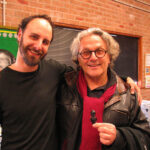Few figures in rock and roll history have possessed the knack for spotting and recruiting guitar talent quite like Ozzy Osbourne. Having spent his formative years alongside Tony Iommi in Black Sabbath, the bar was set astronomically high. This legacy of groundbreaking guitar work became a defining characteristic of Ozzy’s solo career, with a revolving door of exceptional musicians contributing to his distinctive sound. From the revolutionary neoclassical shredding of Randy Rhoads to the modern metal crunch of Zakk Wylde, and the bluesy hard rock of Jake E. Lee, Osbourne’s bands have consistently featured some of the most celebrated guitarists in heavy metal.
Ozzy’s pursuit of guitar excellence was evident from the outset. Rumors abound of auditions with guitar heroes like Gary Moore and George Lynch before he ultimately connected with Randy Rhoads. Rhoads, fresh from Quiet Riot, was the first guitarist to truly define the Ozzy Osbourne solo sound. His collaboration with Osbourne on Blizzard of Ozz (1980) and Diary of a Madman (1981) produced an enduring legacy of heavy metal anthems. Tracks like “Crazy Train,” “Mr. Crowley,” and “Flying High Again” are not just Ozzy staples, but cornerstones of the genre, largely thanks to Rhoads’ innovative blend of classical technique, melodic sensibility, and outright shredding. His tragically early death in 1982 left a void that seemed impossible to fill, but Ozzy’s career was destined to continue, fueled by his determination and an uncanny ability to find exceptional six-string slingers.
Following Rhoads’ untimely passing, Ozzy briefly worked with Bernie Torme and Brad Gillis before finding Jake E. Lee. Lee stepped in and contributed significantly to 1983’s Bark at the Moon. Often positioned between the mythic status of Rhoads and the enduring reign of Wylde, Lee’s contributions are sometimes overlooked. However, his blues-infused, hard-rocking style injected a different, yet equally potent, energy into Ozzy’s music. Albums like Bark at the Moon and The Ultimate Sin (1986) showcase Lee’s fiery playing and songwriting contributions, proving he was far more than just a placeholder. He helped Osbourne navigate a difficult period and solidify his solo career beyond the shadow of Rhoads.
Then came Zakk Wylde, who joined Ozzy’s ranks in 1987 and has become arguably the most synonymous guitarist with the Osbourne solo project outside of Rhoads. Wylde’s tenure has been extensive, spanning multiple stints and countless iconic riffs. His signature pinch harmonics, bluesy bends, and Les Paul-driven tone became integral to Ozzy’s sound from No Rest for the Wicked (1988) onwards. Wylde co-wrote some of Ozzy’s biggest hits, including “No More Tears” and “Mama, I’m Coming Home,” cementing his place in Ozzy Osbourne history. His larger-than-life stage presence and unwavering dedication have made him a fan favorite and a constant presence in the Ozzy Osbourne band for decades.
Beyond these central figures, a constellation of other talented guitarists has graced the Ozzy Osbourne stage and studio. Joe Holmes, Steve Vai, Gus G, Alex Skolnick, and Jerry Cantrell have all contributed their unique skills at various points, adding further depth and texture to Ozzy’s diverse catalog. Even recent albums like Ordinary Man (2020) and Patient Number 9 (2022) showcase a wealth of guitar talent, featuring guest appearances from legends like Slash, Tom Morello, Jeff Beck, and Eric Clapton, alongside producer and guitarist Andrew Watt.
In conclusion, the story of Ozzy Osbourne’s solo career is inextricably linked to the incredible guitarists who have shared the stage and studio with him. From the groundbreaking innovation of Randy Rhoads, through the bluesy grit of Jake E. Lee, to the modern metal force of Zakk Wylde, and the contributions of many others, these musicians have collectively shaped the sound of a rock icon. Ozzy Osbourne’s legacy is not just his own; it’s a testament to his ability to recognize and collaborate with exceptional guitar talent, creating a body of work that continues to inspire generations of musicians and fans alike.

